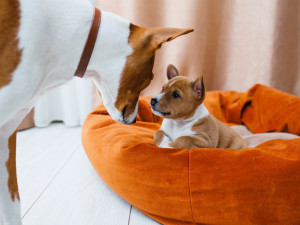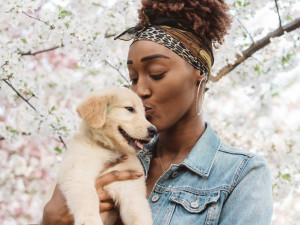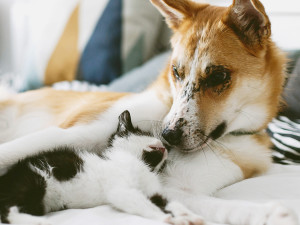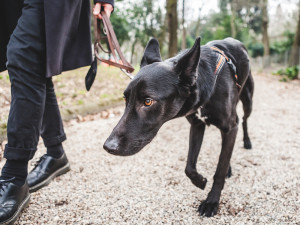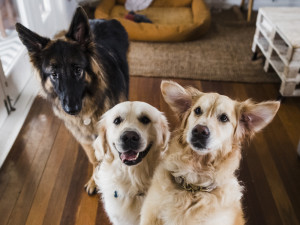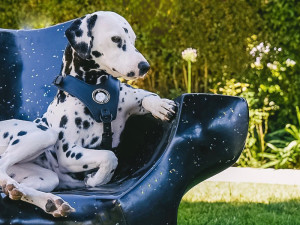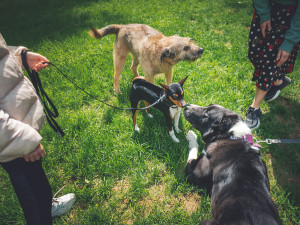Single Puppy Syndrome: One-Puppy Litter
One doesn’t have to be the loneliest number when it comes to your dog.

Share Article
In this Article:
What Are Singleton Puppies?opens in a new tab Challenges With Singleton Puppiesopens in a new tab Raising a Singleton Puppyopens in a new tab Frequently Asked Questionsopens in a new tab
I’m a singleton, but nobody makes a big deal out of it because most humans are born one at a time. My husband is an identical twin whose twin brother calls him his first “wombmate,” and his peculiarity is a source of endless fascination to many people. In dogs, it’s the reverse — most dogs are born with one or more littermate. A rare few, the singletons, are born on their own, as the only puppy.
The challenges faced by singletons summed up with the term “single puppy syndrome” are related to their development. Their behavioral issues often include a lack of bite inhibition, trouble coping with frustrationopens in a new tab, sensitivity to touch, and difficulties in social situations.

littleKin™ is Kinship’s home just for puppy and kitten parents. Bop over to check out expert advice, new pet tools, and special deals—all curated for your newest family member.
opens in a new tabMy personal experience with singleton puppies
A while ago, I met a two-year-old singleton Irish Water Spaniel. He was full of himself, had no frustration tolerance and almost no impulse control. He objected to being touched, which caused him to biteopens in a new tab, and his bite inhibitionopens in a new tab was not great. His issues with frustration and control led to leash aggressionopens in a new tab with other dogs. His pet parent worked hard (so hard!) to change his behavior, but it was a huge project.
The next litter from the same mother was also a solo puppy whose behavior was completely typical, though she was a bit large for the breed — not unusual for singleton puppies. The pet parent did everything right with her second singleton puppy (I’m so proud of her!): She raised her with a Lab litter that was only a few days different in age than her solo puppy, and did everything else I advised. Until her singleton was with the Lab litter, she handled the puppy a lot and pushed him off the mother while feeding, so he had to work to reattach as typical puppies do. She arranged for her puppy to spend time with socially savvy and boundary-setting adult dogs, and focused on socializing the puppy very thoroughly. She did end up spaying the breeding femaleopens in a new tab after the second singleton as there was too high a risk of it happening again.
This second singleton puppy, benefiting from all her parent did to help her, was not behaviorally challenged like so many singletons puppies are. The younger singleton turned out completely normal from a behavioral perspective, despite an unusual beginning, and this is an amazing accomplishment.
What are singleton puppies?
If you’ve ever met a dog named Solo, Uno, or Only, it may be more than just a cute name. The first question I consider asking is whether the dog was the only puppy in their litter. It’s rare, but dogs can give birth to just one pup, and being a singleton puppy can cause issues for the dog (and their human parents) down the road.
What’s the deal with one-puppy litters?
For dogs, like many other species, early experiences are critical for normal social development. The time for true socialization — during which puppies will learn lessons that directly affect lifelong behavior — lasts from weeks three to 14. That’s why puppies have the best chance for normal social development if they are allowed to be with their littermates for seven to eight weeks at least, and maybe through week 10 or 12; it’s not good for puppies to be separated from their littermates before that.
Can a dog only have one puppy?
The record for largest litter is 24 puppies (am I normal for feeling pain just thinking about that?), according to Guinness World Records. Having up to 12 puppies is not unusual, but the average litter size is five to six puppies. Although it’s far more common for dogs to give birth to a group of pups, having just one puppy is possible, and it does happen. A dog can have a one-puppy litter but have more puppies in her next litter.
How rare is single-puppy syndrome?
Single puppy litters are rare, though there’s no agreement about exactly how often it happens. People share information about big litters more often, presumably because they are proud of it and don’t often report smaller litters.
And not all puppies who are the only puppy in a litter face the associated behavioral challenges known as single puppy syndrome, especially because many people take steps to prevent it. So, single puppy syndrome is quite rare, affecting less than one percent of puppies.
What causes a singleton puppy?
There is no one reason that a dog gives birth to just a single puppy. Sometimes, only one puppy starts developing, perhaps because of poor nutrition or due to a mistimed mating in which there is almost no overlap in the time both eggs and sperm are present. Older mothers are more likely to produce singleton puppies, and that may be true for very young mothers, too. Sometimes, there is a single pup because their would-be littermates don’t survive either in utero or the early days after birth. Small dogs have smaller litters, so they are more likely to give birth to a singleton puppy.
Challenges unique to singleton puppies
Singletons grow up in a completely different environment than puppies with littermates, and it affects how they develop in many ways. The littermate experience (being pushed off the nipple during feedings, crowded conditions, working to get food, constant physical contact, being walked over) prepares puppies emotionally and behaviorally to face life as a well-adjusted, emotionally stable adult, but singletons don’t get that preparation. All socialization is about preparation for later in life, so we need to work extra hard to prepare singletons for their life. Their early weeks with just mom don’t naturally provide it.
Lack of proper socialization
Lots of social lessons are learned during play, and those lessons often include boundaries such as not biting too hard, not walking over someone, and leaving another dog alone if they don’t want to play or interact. It’s important for singleton puppies to have lots of interaction early on with other puppies and with boundary-setting adult dogs beyond just mom.
Behavioral issues
It’s common for singleton puppies to be unable to tolerate crowding in space, physical contact such as normal touch and handling, and frustration. Many singleton puppies grow up to be dogs with poor bite inhibition, a tendency to be pushy, and less-than-stellar impulse control.
Physical development
Being overweight and not developing properly with regards to locomotion and movement is sometimes an issue with singletons. It helps to monitor their food intakeopens in a new tab so they don’t overeat. Let them eat whenever they want, but don’t let them stay on the nipple, draining it dry at every feeding. Don’t let the milk bar be open opens in a new tab24/7. Regularly consult with your vet about the puppy’s weight and adjust the feeding interruptions accordingly and with medical advice.
Raising a singleton puppy
If you find out that your dog is a singleton puppy early — any time before the puppy heads to your home — there are things that can be done. Work on teaching bite inhibitionopens in a new tab, and handle the puppy a lot to avoid issues with touch sensitivity. Any gentle, regular handling is likely to help, and who doesn’t love the assignment to touch and hold your puppy a lot? Interrupt their feeding by pushing them gently off the mother so they must reattach to the nipple. This helps them get them used to life’s little frustrations. Have the puppy spend time with other puppies of the same age as much and as early as possible.
If at all feasible, raise the singleton puppy with another litter. Spending a lot of time with another litter lets a singleton have a more typical or normal experience as a young puppy. The adorable play between puppies, which is so charming to watch, is anything but light-hearted frivolous behavior — it provides puppies the foundation for normal, healthy social behavior as adults in many contexts and is a critical part of a puppy’s development and education.
Do singleton puppies have health issues?
The survival rate of singleton puppies is not as high as for puppies born with littermates. One issue before birth is that a single puppy often doesn’t produce enough hormones to induce labor in the mother, so the pregnancy extends too long.
That can lead to a loss of oxygen and nutrients to the puppy, or it can lead to a puppy growing too big for a safe birth. Many veterinarians perform caesarian sections on dogs who are pregnant with a single puppy. Research about health problems after birth in puppies without littermates is sparse, and there is not enough to say definitively whether there are patterns of health issues in singletons.
What should you consider when training a singleton puppy?
Training a singleton puppy may require extra patienceopens in a new tab; these puppies are prone to becoming frustrated easily. With that in mind, keep sessions extra short and always start and end each session with an easy skill so the puppy is successful. Practice skills requiring impulse control, such as “wait” and “stay,” to help your singleton puppy strengthen their self-control.
Reinforce them for taking treats gently, and keep your hand open and flat with a treat in your palm when giving treats to help them learn to take treats nicely. Give them further practice using their mouth appropriately by playing fetchopens in a new tab and tugopens in a new tab and asking them to drop the toy as part of the game. Training a singleton puppy is much like training any other puppy, but they are more likely to need extra practice with some skills.
Early interventions for singleton puppies
The big differences between the environment of a singleton and of a litter with multiple puppies occur in the first few months of their life. That’s when it’s most important to be proactive about interventions for the singleton. They need lots of physical contact with people and other puppies if possible. Even giving them plenty of knotted towels or stuffed animals to touch and bump into helps them get used to feeling crowded. They should be pushed away when feeding so they get used to being frustrated and to problem-solving when they must find the nipple again and reattach to it.
Socialize the puppy early
All puppies benefit from early socialization, but in the case of singletons, the risks of not having sufficient socialization are even higher. Solo puppies should be exposed to other puppies as well as to gentle people who pick them up, touch them, and handle them a lot. They need lots of early experiences with other young puppies as well as dogs of all ages.
Frequent interactions with humans and other dogs
Singleton puppies typically have far fewer interaction with other dogs in their early weeks than puppies with litters. To counteract that and provide them with these crucial early experiences, make sure singletons have lots of interactions with other dogs, both puppies and adults. It’s also critical to get them used to being picked up, handled, and touched in a variety of (gentle) ways by people, so they can tolerate physical contact later in life.
Use surrogate littermates
One of the best ways to provide singletons with the necessary experiences for normal behavior development is with surrogate littermates. Raising a singleton with another litter or adopting similar-age puppies to be raised with the singleton by the mom can prevent many issues singletons usually face. They may not have been with littermates in utero, but it’s best for them to be raised alongside other puppies as soon as possible after birth.
Final thoughts: How to ensure your singleton puppy becomes a well-adjusted adult
Remember from day one that a singleton puppy is in an unusual environment for their species. It’s up to you to help them gain the skills and experience most puppies get from being with their litter for a couple of months. It’s important to start right away making adjustments to the singleton’s care and daily life.
So, if you find yourself with a singleton pup, work on teaching bite inhibition early on, handle the puppy often to discourage touch sensitivity, and help the puppy experience interruptions and frustration. Most importantly, encourage the puppy to spend time with other puppies of the same age as much and as early as possible in those first 12 weeks.
FAQs
Is it normal for a dog to have one puppy?
It is unusual for a dog to have one puppy. Considering the challenges faced by singleton pups, it is fair to assume that having a litter of only a single puppy is not normal.
Are singleton puppies bigger?
Sometimes singleton puppies are bigger, probably because they get all the nutrition meant to be shared with other puppies. However, if health or nutrition deficiencies led to one puppy, they may not be bigger.
Should you adopt a singleton puppy?
Adopting a singleton puppy is a challenge. It should only be considered by someone who is well aware of the potential difficulties and accepts that the puppy is less likely to develop into a dog with normal behavior than dogs who had littermates.
Are singleton puppies more likely to be aggressive?
Without any intervention, singleton puppies do face a greater risk of being aggressive, which is why being proactive to help a singleton puppy develop normally is so critical. The reason solo pups may be aggressive is that their behavioral challenges are the sort of issues that lead to aggression issues. That is, they are sensitive to handling (and may therefore be uncomfortable enough to bit in response to normal physical contact) and often struggle to tolerate frustration, which can also lead to aggression.
Compounding the issue is that many singleton puppies don’t develop proper bite inhibition, meaning that if they do bite, they may cause serious injury. With intervention, solo pups can overcome these challenges, develop normally, and not be any more likely to behave aggressively than those dogs who grew up with a litter of their own.
References
Bojja, Chandana, Chandra Prasad Borra, and Srinivas Manda. “Single puppy syndrome and its management in two casesopens in a new tab.”(2024).
Peetala, Vijay, et al. “Clinical efficacy of mifepristone and misoprostol in induction of parturition in female dogs with single pup syndromeopens in a new tab.” International Journal of Livestock Research 9.8 (2019): 257-262.
Shekher, Sarswat Chandra, et al. “A rare case of single pup syndrome and its management in Labrador bitch: A case reporopens in a new tabt.” Jour of Ent and Zoo Stud 8.4 (2020): 1723-1724.

Karen B. London, PhD, CAAB, CPDT-KA
Karen B. London, Ph.D., is a Certified Applied Animal Behaviorist and Certified Professional Dog Trainer who specializes in working with dogs with serious behavioral issues, including aggression, and has also trained other animals including cats, birds, snakes, and insects. She writes the animal column for the Arizona Daily Sun and is an Adjunct Professor in the Department of Biological Sciences at Northern Arizona University. She is the author of six books about training and behavior, including her most recent, Treat Everyone Like a Dog: How a Dog Trainer’s World View Can Improve Your Lifeopens in a new tab.
Related articles
![dog and cat snuggling together]() opens in a new tab
opens in a new tabAnimal House: How to Intro a New Dog to Your Other Pets
...Without turning your home into a circus.
![Shy black dog walking with owner at the park.]() opens in a new tab
opens in a new tabHow to Help an Anxious Dog Conquer Their Fears
Pro tips for boosting the confidence of a scaredy-cat dog.
![3 dogs posed together in a house]() opens in a new tab
opens in a new tabDoes Your Dog Have a Unique Personality?
Yep, research says your dog is as special and perfect as you tell them they are.
![Puppy hides under the couch in fear]() opens in a new tab
opens in a new tabHow to Keep Your Dog From Freaking Out When You Have Company
Do these things to help your pup (and your guests) feel chill.
![a Dalmation sits in a black chair]() opens in a new tab
opens in a new tabMerci Collective’s Crystal-Infused Products Are Calming Anxious Pets
Whether or not you believe in crystal healing, Chani Ronez’s chic, customizable, and sustainable products are designed to help treat everything from separation anxiety to joint pain to GI issues.
![Three dogs on leashes meeting and sniffing each other on a walk on the summer grass with owners]()
How Do I Get My Shy Dog To Socialize?
Kinship Collective dog trainer Robert Haussmann’s tips for getting a shy pup to go from wallflower to social butterfly.
